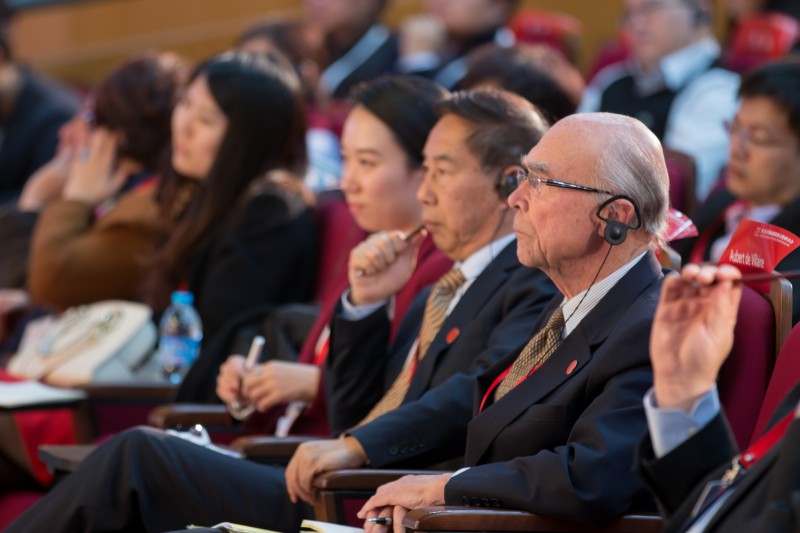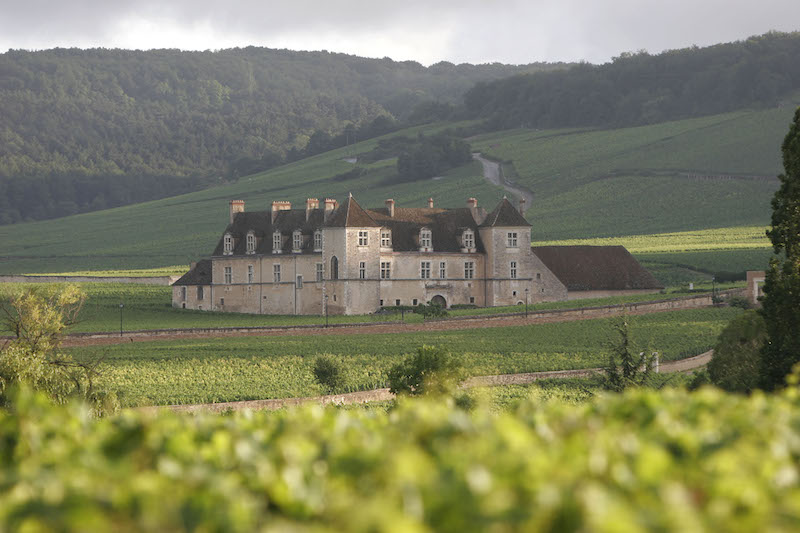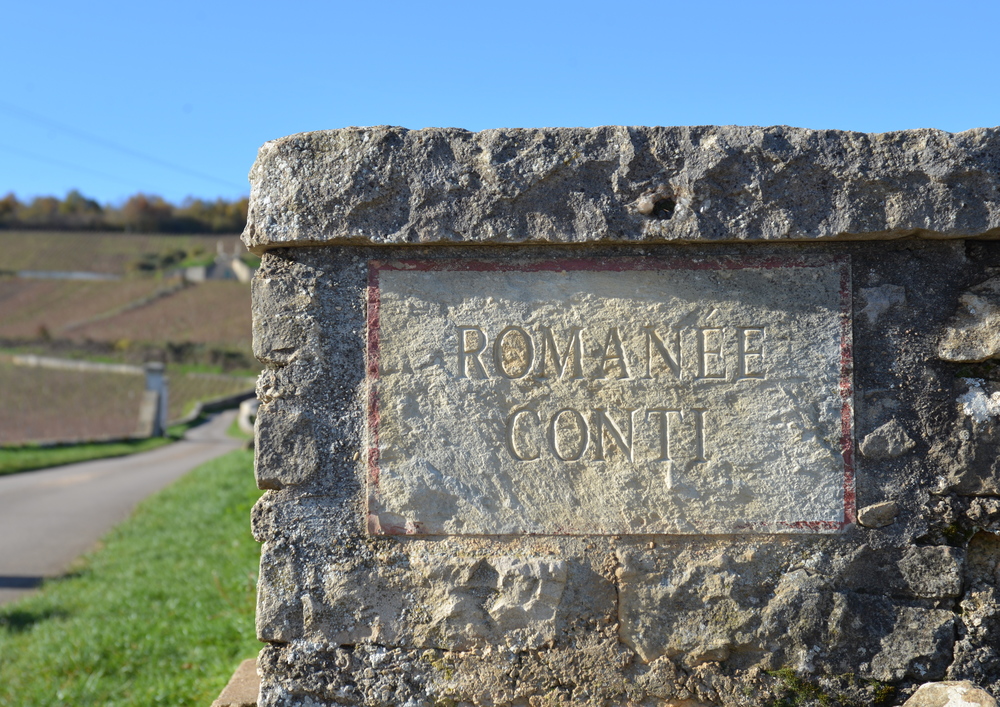At the “International Terroir Symposium” the last speaker was Mr. Aubert de Villaine, the co-owner of Domaine de la Romanée-Conti and Chairman of the Association des Climats du Vignoble de Bourgogne. He spoke eloquently to the audience, recounting the 2,000-year history of Burgundy, the arduous nine-year journey to secure a place on the World Heritage list, and the essence of the terroir philosophy. Later that evening, as we drove Mr. de Villaine to the airport for his return to France, just before getting out of the car, he said, “If I have one piece of advice to offer about wine, it is this: To make great wine, one needs humility (Pour faire des grands vins, il faut l’humilité).” At 76 years old, he traveled a great distance to China to share and convey the spirit of wine terroir, and we are sincerely grateful to him. We believe that wine lovers in China will also appreciate his efforts.

In 2006, we officially launched the candidacy of the Climats of Burgundy for UNESCO World Heritage status.
But first, what is a “Climat” in Burgundy? What makes this concept unique in the world of wine? I will try to explain this as clearly as possible, and also summarize for you, the long journey or rather adventure that over nine years led to the inscription of our Climats site on the World Heritage list on July 4th.

According to the World Heritage Convention, a cultural site is defined as a work of both man and nature that possesses Outstanding Universal Value (OUV), meaning it is an exemplary unique site whose destruction, even partial, would be a loss to humanity as a whole.
We had to demonstrate that the Climats of Burgundy possessed OUV. This was the purpose of what UNESCO calls the scientific dossier.
We quickly chose not to limit the demonstration of OUV to the scenic aspect of the site. The site of the Climats is indeed very beautiful, often picturesque, but it is not just the landscapes, at least not solely the landscapes, that justify its inscription as a cultural site on the World Heritage list. It is rather the construction of this site over 2000 years of history and the combined action of man and nature that form the basis of our demonstration of OUV. We wanted to show that Burgundy as we know it today is the result of an exceptional encounter that could very well not have happened between a place, men, and a noble plant, the vine, and that from this encounter a culture was born.
This encounter went through difficult, painful phases, but due to the resilience, perseverance, and stubbornness of its main actors: the monks, the dukes, and the winegrowers, it bore incomparable fruit since it made our region the world cradle and archetype of all terroir-based viticultures.
From a geography that was initially unfavorable, man succeeded over 2000 years of history in producing wines whose quality is recognized worldwide, hierarchizing them according to the talent allocated to each by nature, and finally gaining worldwide recognition for this hierarchy through the AOC system.
I will first summarize the scientific dossier from the dual perspective of geography and history.
Geography
To begin with, it should be noted that the word “Climat” comes from the Greek “klima” with a “k,” which means inclination or exposure. One might almost think that this etymology was fabricated a posteriori to make it easier for us 21st-century Burgundians to explain our history and that of our wines. Because, of course, we use the term “Climat” in a sense closer to the Greek etymology than to the modern dictionary definition. As Bernard Pivot says:
“In Burgundy, when we talk about the Climat, we don’t look up to the sky, we look down to the ground. Burgundy is the only wine region that can boast of having a climate in the sky and 1,247 Climats on the ground.”
In Burgundy terminology, a “Climat” is a plot of land with a name that has often remained the same for almost a thousand years, a specific subsoil, a particular exposure, unique hydrometric characteristics, and therefore ultimately a particular microclimate. This Climat produces a wine that cannot be produced or imitated anywhere else. Thus, in our Climats of Burgundy, we have chosen to link the wine to the place in the finest way possible, without ever deviating from this over our 2000 years of history. The result is a mosaic of 1,247 different Climats in the Côte de Beaune and Côte de Nuits, where a seemingly ungrateful land speaks in the most subtle and nuanced way possible, expressing a whole palette of different sensations depending on the plot; resulting in a hierarchy that we will define in the 20th century in “village,” “premier cru,” and “grand cru” appellations.
The area of the Climats of Burgundy today inscribed as World Heritage is this mosaic located on a strip of land about 60 kilometers long from Dijon in the north to the vineyards of Maranges in the south, and only about one kilometer wide on average. It is a slope, an escarpment whose maximum altitude does not exceed 350-400m, the result of the uplift and fracture of the granitic basement and its marine sedimentary cover 30 million years ago. The presence of numerous satellite faults explains the great diversity of the soils, which are composed of geological layers of different ages and types. Our Climats are laid out on this slope, forming a patchwork of vineyard plots which, even when joined, produce wines of different character.
Les Climats is located in an area that may seem too northerly for vines, but it’s at a Climatic crossroads that’s unique in the world: the Mediterranean brings its mildness, and even its summer heat, with the foehn effect particularly noticeable at mid-slope; the Morvan protects it from bad weather coming from the west, and it’s too far west to suffer from the harshness of a continental climate. And the slope faces east, towards the rising sun that caresses our rows of vines in the early hours of the morning. Stone, which is very present on the soil surface, stores up the sun’s heat during the day and releases it to the plants at night.
But what immediately strikes the first-time visitor are the soils, these Burgundian clay-limestone soils which at first glance appear so unsuitable for any kind of cultivation, that one wonders what prompted our ancestors to try cultivating this plant two thousand years ago. It has to be said that the first vines, discovered quite recently in Gevrey-Chambertin and dating back to 100 A.D., were planted on the plain, at the bottom of the hillside, in richer, deeper soil than on the hillside itself. But as we shall see, it was precisely the priori hostile soil of the hillside that sublimated man’s genius and enabled him to extract the very essence of the vines, in the form of a nectar of unrivalled subtlety and complexity.
Two towns are integral to the geography of the Climats de Bourgogne: Dijon, residence of the Dukes of Burgundy, who played a key role, alongside the monks, in the foundation of modern Burgundy – we’ll come back to this later – and Beaune, home to all the major Burgundy trading houses, Beaune with its kilometers of cellars that form an extraordinary labyrinth beneath the city, Beaune where Nicolas Rolin had the famous Hôtel-Dieu built in 1443, and which even today punctuates the professional calendar with its annual auction on the third Sunday in November. Thus, Dijon and Beaune were the centers of political, economic, cultural and religious power during the most important period in Burgundian history, from the 10th to the 15th century. Between these two towns, Burgundy’s villages follow one another within a few kilometers of one another, often nestling in one of the many valleys that punctuate the hillside at regular intervals.
This, in a nutshell, is the wine-growing landscape of the Climats de Bourgogne. It’s a narrow hillside, facing east and south-east, with a wide variety of soil and subsoil characteristics due to major geological accidents, making it ideal for parcel differentiation.

(Interaction with Audience)
History in Key Stages
100 AD
This is the first chronological point to remember. It is the starting point of 2000 years of history, 2000 years of labor and groping, generation after generation, refining the knowledge of places, soils, subsoils, sun exposure, hydrometrics… all the specific characteristics of each plot to determine their exact limits and then hierarchize them. So, if the starting point in the history of the Climats de Bourgogne is the Gallo-Roman vineyard of 100 A.D., then the milestone is represented by the decrees of 1936-1938, which set in stone the Appellations d’Origine Contrôlée and the hierarchy of appellations between Village, Premier Cru and Grand Cru, which, with very few exceptions, are still in force today.
Between the year 100 and 1936, our history was marked by intermediate stages. But little by little, the desire to link wine to the place in which it is produced took hold, and Burgundy became, indisputably, the model for so-called “terroir” viticulture. For us, a plot of land produces a cuvée; this cuvée produces a wine, i.e., a specific label, which is therefore the aromatic and gustatory expression of the soil on which it is produced.
But let’s return to the main stages in our history:
From the 6th to the 8th centuries
From the 6th century, the vine is planted on the slope and no longer just in the plain. It is realized that despite poorer soils, the vine produces better quality wines. From this time, it is understood that the best wines will be produced on the “piémont,” this low-slope area from the middle to the bottom of the slope. At the same time, the first legal protections for the vine also appear. Viticulture imposes itself at the center of Gallo-Roman society.
A century later, just a century later, one already speaks of the wine from Clos de Bèze in Gevrey-Chambertin. A wine is thus already identified by the place where it was produced.
900 to 1100 – The Primordial Role of the Monks
The period from 900 to 1100 was crucial for Burgundy. Benedictine monks founded Cluny (in 910) then Cîteaux (in 1098). These two abbeys were to have a considerable and definitive impact on Burgundy, for it was the monks who founded them the first to work on the cultivation of Pinot Noir and Chardonnay as the sole grape varieties for the production of great wines, and on the hierarchization of Climats as we know it today. The monks quickly understood the importance of promoting the quality of Burgundy wines above all else. With the power of the church, and in particular its financial power, the monks improved the quality of the wines they produced, increased their reputation, invested massively to build vats, cellars and other buildings to vinify and then preserve the wine, and finally developed new markets for their products. Clos de Vougeot is of course the most famous expression of the Burgundian architecture inherited from the monks.

As early as this period, the first clos appeared, with paths, low walls and meurgers demarcating the plots that became known as Climats. Limestone, a watermark in all our Burgundy wines, is present in large quantities in our vineyards. Winegrowers use it to build their walls, cabotes, cellars and cuveries.
From the 10th to the 15th century
Thanks to their power and influence throughout Europe, the Valois Dukes of Burgundy gave Burgundy wines considerable economic and cultural influence. They quickly understood the importance of controlling the quality of wines produced in Burgundy for commercial purposes. The final markets for Burgundy wines were generally far from their place of production (for example, the Netherlands) and were not connected to Burgundy by road or river links. It was therefore important to produce high-quality wines whose value and reputation justified the expensive transport and could withstand the journey.
During this period, a very large number of Climats and lieudits received their names and definitive boundaries. But the most important event of this period was undoubtedly the Edict of 1395.
Philippe le Hardi (Duke of Burgundy in 1363) issued an edict in 1395 prohibiting the cultivation of Gamay on Burgundy’s hillsides. He justified this decision on the grounds that Gamay wine was more productive, but also more common, than Pinot Noir. The edict was not popular, but Philippe le Hardi was right. Little by little, Pinot Noir is becoming the instrument by which Burgundy wine expresses its soils, terroir and Climat. If we use the vocabulary of music, we could say that Pinot Noir (or Chardonnay for white wines) is to Climat what the bow is to the violin.

The world’s rarest Stradivarius is just a silent piece of wood without its bow. In the same way, our Burgundian Climats could not express their full diversity without this particular grape variety, which thrives in our clay-limestone soils. It is the uniqueness of the grape variety, the absence of blending, that allows the full range of sensations derived from the terroir and the sap of the vine to fill our glass of Clos de Tart, Chambertin or Clos des Chênes. When two adjacent terroirs, both planted with Pinot Noir, produce two different wines, it’s the terroir that expresses itself, not the grape variety or the winemaker.
Philippe Le Hardi’s decision definitively oriented Burgundy towards quality, the pursuit of excellence and, progressively, the hierarchization of Climats. The emergence of places with specific characteristics, delimited, named and protected by custom and tradition, continued during this period, supported by demanding production standards drawn up by monks, dukes and winegrowers.

Modern Era
The notion of “Climat” really appeared in Burgundian writings in the 16th century, although a document from 1484 already mentions it in connection with Clos de Bèze. From the 16th century onwards, vines were planted on the hillsides, and the great Climats were already recognized. At the same time, the experience of winegrowers was sufficient to ensure that the main Burgundian oenological practices were already well established, to such an extent that their general principles remained virtually unchanged to this day.
In the 18th and 19th centuries, the use of the name Climat rapidly spread to designate parcels whose wines were identifiable. Côte de Beaune wines, known until the 17th century under the generic name of Vins de Beaune, are now identified by their original Climat, notably Clos de Vougeot, the aforementioned Clos de Bèze, Romanée and Clos de Tart.
In the 19th century, the first official classifications appeared. The various Climats known and recognized since the Middle Ages were listed according to an indisputable hierarchy, and the wines were described in terms of their qualities and differences, according to the Climat from which they came. Morelot’s classification dates from 1831, Lavalle’s from 1855. Consumer maps appeared, showing the different Climats in each village.
1936-1938
Winegrowers were behind the 1936 and 1938 A.O.C. decrees, which followed on from the 1919 law. The notion of Appellation d’Origine Contrôlée appeared in the 1936-1938 decrees. It precisely delimits the Climats, recognizes the know-how of men through loyal and constant local practices, and imposes a highly hierarchical classification. Today, this AOC system has proved to stand the test of time. These decrees thus appear to be the result of 2,000 years of history in a geography that was a priori hostile, or at the very least unfavorable. This is what makes Burgundy unique, and we can only be grateful to the successive generations who, through perseverance and humility, have understood what they could get out of this small strip of land by identifying, first empirically, then more scientifically, the tiniest Climatic differences separating each parcel, and by imposing strict oenological practices, applied only to Pinot Noir and Chardonnay grapes, the catalysts of the aromatic revelation of our soils.

Justification of Outstanding Universal Value
The scientific dossier thus demonstrates that the Climats are the result of the history of mankind as inscribed in the soil, giving rise to a specific and unique model of viticulture that possesses Outstanding Universal Value.
The heritage property proposed for inscription is indeed a cultural site, as defined in Article 1 of the above-mentioned Convention, for the following main reasons:
- Over a very long period of time, a wine-growing parcel has been precisely defined by a human community that has recognized the exclusive reference to place as an essential element in the quality and diversity of the wines produced there; this is an unparalleled cultural phenomenon.
- This cultural construction, which has gone on uninterrupted for 2,000 years, has been largely based on the know-how and human experience of those involved in the area, and on the interdependence between the towns, as centers of normative decision-making and marketing, and the Côte, as a place of production; thus, Dijon, as a place of power, has built up a system of norms that has been refined over the centuries, culminating in an extremely precise delimitation, hierarchization and legal protection of the Climats.
- This historical construction over a long period of time has given rise to a specific model of viticulture based on ancestral knowledge and know-how, highlighting the unique link between each wine and the place that produced it.
- The specificity of this historical construction is perpetuated in the Appellation d’Origine Contrôlée (AOC) system, the official translation in the 20th century of over a thousand years of viticultural practices.
Thus, to fully understand the Climats of Burgundy vineyard site and its Outstanding Universal Value, it is not enough to look at the landscape; one must also understand the patient construction of its viticulture model. Where a landscape would “show” attributes associated together by the eye of the observer, the Climats cultural site reveals the historical strata that have associated vineyards, villages and towns in its very construction. In the materiality of land parcels, housing and towns, it restores the “seeing and knowing” that make it a living, exemplary human construction.
Our generation has a duty of conservation, certainly, but I also believe we have the duty to pass on to the next generation terroirs in better condition than when they were passed down to us.
We are well aware of the dramatic consequences for our vineyards of the widespread use of weedkillers, fungicides and all the phytosanitary products that were discovered and aggressively marketed in the post-war period. We also know that the exponential sophistication of our tractors, and the parallel increase in their weight, contributes to exaggerated soil compaction. Finally, we know that clones, for all their advantages, are a threat to the diversity of Pinot Noir and Chardonnay grape varieties, and therefore to the complexity of our wines.
That’s why Burgundy is today so strongly committed to a viticulture that is more respectful of the terroir, more attentive to nature, more in tune with the rhythm of the seasons. If we stray from this philosophy, we risk losing what has been so patiently and painstakingly built up over 2000 years: the expression of our Climats in all their complexity.
It was these observations and the immense surprise that this idea of Climat had withstood so many wars and human or natural plagues, and that it was still alive and well, that crystallized in my mind and in that of a few Burgundians bound by a common love of Burgundy the certainty that these Climats, thrown together like a jigsaw puzzle of 1247 pieces on this ribbon of barely 60 kms that runs from Dijon to south of Beaune, represented a unique manifestation of human genius, They had proved their resilience, but they also showed a certain fragility in a modern technological world where shortcuts and ease are sought after, and where visions are always short-sighted. Inclusion on Unesco’s prestigious World Heritage list seemed to us to be the obvious way of both asserting the universal value of the idea of Climat, and above all making the local population, and in particular the winegrowers, aware that the heritage entrusted to them by history is unique and exceptional, that it has universal value, and that it is therefore their duty to ensure its protection.

This is the purpose of the application we have been leading since 2006 with the association I chaired, which resulted in the inclusion of the Climats de Bourgogne on the Unesco World Heritage List on July 4 as a cultural site.
It’s been a wonderful adventure. A struggle too. A banner was needed: this was the idea of Climat as Burgundy has constructed it over 2000 years, and which I have tried to explain to you as clearly as I could. It wasn’t easy, but the V.U.E. is recognized and the word Climat is now used throughout Burgundy and even abroad to designate a Burgundian terroir.
Then, we had to demonstrate that these Climats had Outstanding Universal Value, and that was perhaps the most exciting stage of the project when we worked with a team encompassing many scientific disciplines: historians, archaeologists, geologists, pedologists, sociologists, oenologists, INAO, and many others with whom we wrote a declaration of OUV, which is today the very heart of the inscription as the World Heritage Committee endorsed it.
But the World Heritage inscription is not an end in itself; it is also the obligation to manage, balancing the economic activity, which it is out of the question to freeze – even if we wanted to, we couldn’t achieve it! – and the cultural riches of the Côte. This is the role of the management plan, which, prior to listing, must provide for the protection and management of both the landscapes and the buildings of the Côte.
It was a tough job. It took us 8 years, which is a short time, since the average is 10 years. It wasn’t a sure thing, but we met the challenge and succeeded. It’s now accepted that the wines produced in the Climats area are much more than just wine. They express and transmit a culture. I think we’ve proved that World Heritage listing is the right lever to better understand, better publicize, better promote and better protect the exceptional, unique character of this culture of which we are the guardians.
It’s also interesting to note that this registration of Climats, which promotes terroir-based viticulture, comes at a time when, contrary to what the film Mondovino predicted a few years ago – the victory of the major international groups and varietal wines, and the demise of terroir-based wines – the opposite has actually happened, Enthusiasts the world over are looking for the expression of terroir in the wines they buy, wines in which they find – and I borrow this fine expression from JR Pitte – the “geographical emotion” provided by the nuances found in a terroir wine and never found in wines with standardized tastes where the soul is missing.
I think Bernanos once said, “What weighs down a man are his dreams”. At my age, when we’re closer to the end than the beginning, I know that I weigh no more than the weight of my dreams. That’s enough for me. At the end of the day, as our English friends say, when you look back, that’s all that’s left, not what you’ve achieved, but what you’ve dreamed… This intangible part is at the heart of these Climats, which are ultimately, and this is their strength, a very old and stubborn human dream.


 中文
中文



